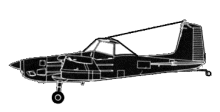
ASN Wikibase Occurrence # 207628
This information is added by users of ASN. Neither ASN nor the Flight Safety Foundation are responsible for the completeness or correctness of this information.
If you feel this information is incomplete or incorrect, you can submit corrected information.
| Date: | Friday 4 August 2017 |
| Time: | 09:00 |
| Type: |  Cessna A188B |
| Owner/operator: | Private |
| Registration: | N3047J |
| MSN: | 18803596T |
| Year of manufacture: | 1979 |
| Total airframe hrs: | 7845 hours |
| Engine model: | Lycoming IO-540-S1A5 |
| Fatalities: | Fatalities: 0 / Occupants: 1 |
| Aircraft damage: | Substantial |
| Category: | Accident |
| Location: | Marshall, MO -
 United States of America United States of America
|
| Phase: | Take off |
| Nature: | Agricultural |
| Departure airport: | Marshall, MO (MHL) |
| Marshall, MO (MHL) | |
| Investigating agency: | NTSB |
| Confidence Rating: |
After takeoff for the agricultural application flight and when the commercial pilot reduced engine power to climb, the engine "surged." He increased the throttle, but the engine "surged" again. He subsequently applied full throttle, but he was unable to maintain a positive climb rate. The airplane gradually settled into a bean field off the end of the runway. The airplane impacted a fence before coming to rest in an adjacent field. The pilot stated that the airplane seemed to be "sagging" after takeoff but that the engine instrument indications appeared to be normal.
Postaccident engine examination did not reveal evidence of any preimpact anomalies that would have precluded normal operation. The reason for the engine surging reported by the pilot could not be determined. According to the pilot, the airspeed indicator was inoperative at the time of the accident. It is likely that the pilot's inability to monitor the airspeed due to the lack of an operative airspeed indicator led to the pilot's failure to maintain adequate airspeed, his exceedance of the airplane's critical angle of attack and the subsequent aerodynamic stall/mush and degraded climb performance.
Probable Cause: The pilot's inability to accurately monitor the airplane's airspeed after takeoff due to an inoperative airspeed indicator, which resulted in the pilot's failure to maintain adequate airspeed and his exceedance of the airplane's critical angle of attack and the subsequent aerodynamic stall/mush and degraded climb performance.
Accident investigation:
 |
|
Sources:
NTSB
Location
Revision history:
| Date/time | Contributor | Updates |
|---|---|---|
| 15-Mar-2018 20:13 | ASN Update Bot | Added |
Corrections or additions? ... Edit this accident description
The Aviation Safety Network is an exclusive service provided by:


 ©2024 Flight Safety Foundation
©2024 Flight Safety Foundation